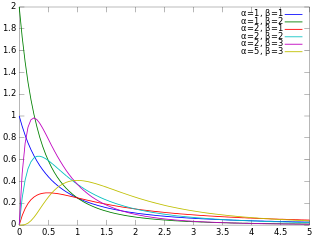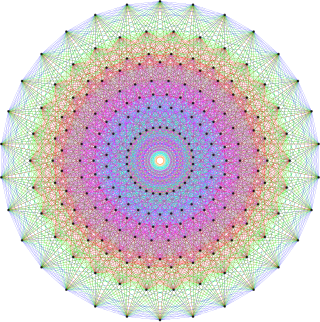In coding theory, the Bose–Chaudhuri–Hocquenghem codes form a class of cyclic error-correcting codes that are constructed using polynomials over a finite field. BCH codes were invented in 1959 by French mathematician Alexis Hocquenghem, and independently in 1960 by Raj Chandra Bose and D.K. Ray-Chaudhuri. The name Bose–Chaudhuri–Hocquenghem arises from the initials of the inventors' surnames.

In probability theory and statistics, the gamma distribution is a versatile two-parameter family of continuous probability distributions. The exponential distribution, Erlang distribution, and chi-squared distribution are special cases of the gamma distribution. There are two equivalent parameterizations in common use:
- With a shape parameter k and a scale parameter θ
- With a shape parameter and an inverse scale parameter , called a rate parameter.

The alpha process, also known as alpha capture or the alpha ladder, is one of two classes of nuclear fusion reactions by which stars convert helium into heavier elements. The other class is a cycle of reactions called the triple-alpha process, which consumes only helium, and produces carbon. The alpha process most commonly occurs in massive stars and during supernovae.
In computer science, a one-way function is a function that is easy to compute on every input, but hard to invert given the image of a random input. Here, "easy" and "hard" are to be understood in the sense of computational complexity theory, specifically the theory of polynomial time problems. Not being one-to-one is not considered sufficient for a function to be called one-way.
In cryptography, the Elliptic Curve Digital Signature Algorithm (ECDSA) offers a variant of the Digital Signature Algorithm (DSA) which uses elliptic-curve cryptography.
In cryptography, the McEliece cryptosystem is an asymmetric encryption algorithm developed in 1978 by Robert McEliece. It was the first such scheme to use randomization in the encryption process. The algorithm has never gained much acceptance in the cryptographic community, but is a candidate for "post-quantum cryptography", as it is immune to attacks using Shor's algorithm and – more generally – measuring coset states using Fourier sampling.
The Cayley–Purser algorithm was a public-key cryptography algorithm published in early 1999 by 16-year-old Irishwoman Sarah Flannery, based on an unpublished work by Michael Purser, founder of Baltimore Technologies, a Dublin data security company. Flannery named it for mathematician Arthur Cayley. It has since been found to be flawed as a public-key algorithm, but was the subject of considerable media attention.
The Cramer–Shoup system is an asymmetric key encryption algorithm, and was the first efficient scheme proven to be secure against adaptive chosen ciphertext attack using standard cryptographic assumptions. Its security is based on the computational intractability of the Decisional Diffie–Hellman assumption. Developed by Ronald Cramer and Victor Shoup in 1998, it is an extension of the ElGamal cryptosystem. In contrast to ElGamal, which is extremely malleable, Cramer–Shoup adds other elements to ensure non-malleability even against a resourceful attacker. This non-malleability is achieved through the use of a universal one-way hash function and additional computations, resulting in a ciphertext which is twice as large as in ElGamal.
Pollard's rho algorithm for logarithms is an algorithm introduced by John Pollard in 1978 to solve the discrete logarithm problem, analogous to Pollard's rho algorithm to solve the integer factorization problem.

In probability theory and statistics, the inverse gamma distribution is a two-parameter family of continuous probability distributions on the positive real line, which is the distribution of the reciprocal of a variable distributed according to the gamma distribution.

In probability theory and statistics, the beta prime distribution is an absolutely continuous probability distribution. If has a beta distribution, then the odds has a beta prime distribution.
Integrated Encryption Scheme (IES) is a hybrid encryption scheme which provides semantic security against an adversary who is able to use chosen-plaintext or chosen-ciphertext attacks. The security of the scheme is based on the computational Diffie–Hellman problem.
Two variants of IES are specified: Discrete Logarithm Integrated Encryption Scheme (DLIES) and Elliptic Curve Integrated Encryption Scheme (ECIES), which is also known as the Elliptic Curve Augmented Encryption Scheme or simply the Elliptic Curve Encryption Scheme. These two variants are identical up to the change of an underlying group.
In cryptography, XTR is an algorithm for public-key encryption. XTR stands for 'ECSTR', which is an abbreviation for Efficient and Compact Subgroup Trace Representation. It is a method to represent elements of a subgroup of a multiplicative group of a finite field. To do so, it uses the trace over to represent elements of a subgroup of .

The Fréchet distribution, also known as inverse Weibull distribution, is a special case of the generalized extreme value distribution. It has the cumulative distribution function
CEILIDH is a public key cryptosystem based on the discrete logarithm problem in algebraic torus. This idea was first introduced by Alice Silverberg and Karl Rubin in 2003; Silverberg named CEILIDH after her cat. The main advantage of the system is the reduced size of the keys for the same security over basic schemes.
In cryptography, learning with errors (LWE) is a mathematical problem that is widely used to create secure encryption algorithms. It is based on the idea of representing secret information as a set of equations with errors. In other words, LWE is a way to hide the value of a secret by introducing noise to it. In more technical terms, it refers to the computational problem of inferring a linear -ary function over a finite ring from given samples some of which may be erroneous. The LWE problem is conjectured to be hard to solve, and thus to be useful in cryptography.
In probability theory, a beta negative binomial distribution is the probability distribution of a discrete random variable equal to the number of failures needed to get successes in a sequence of independent Bernoulli trials. The probability of success on each trial stays constant within any given experiment but varies across different experiments following a beta distribution. Thus the distribution is a compound probability distribution.
In coding theory, Zemor's algorithm, designed and developed by Gilles Zemor, is a recursive low-complexity approach to code construction. It is an improvement over the algorithm of Sipser and Spielman.

This is a glossary for the terminology applied in the mathematical theories of Lie groups and Lie algebras. For the topics in the representation theory of Lie groups and Lie algebras, see Glossary of representation theory. Because of the lack of other options, the glossary also includes some generalizations such as quantum group.
Quantum secret sharing (QSS) is a quantum cryptographic scheme for secure communication that extends beyond simple quantum key distribution. It modifies the classical secret sharing (CSS) scheme by using quantum information and the no-cloning theorem to attain the ultimate security for communications.











































